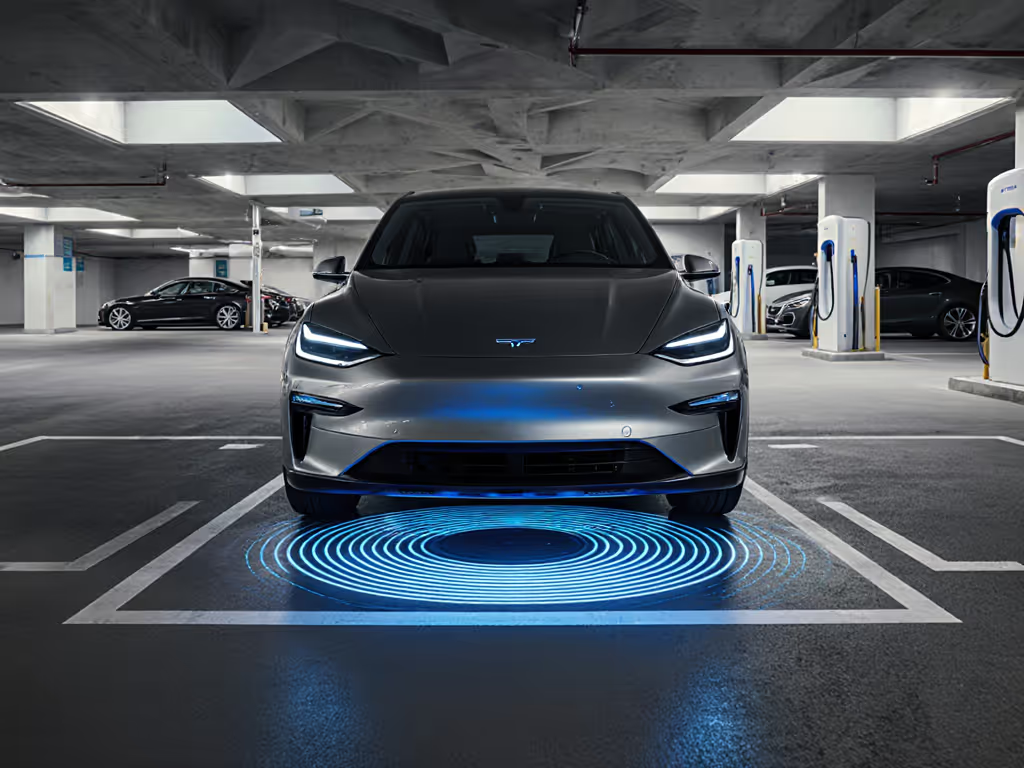
How SAE J2954 Standardizes EV Wireless Charging

The SAE J2954 standard establishes the first global specification for wireless charging of light-duty electric vehicles, enabling interoperability between vehicles and charging infrastructure. It defines power transfer up to 11 kW with 93% efficiency while solving critical alignment challenges through the Differential Inductive Positioning System (DIPS). By creating a unified framework, J2954 eliminates fragmentation in the electric vehicle wireless protocol market and paves the way for mass EV adoption. For infrastructure scope, scaling paths, and dynamic-roadway concepts, see our guide to EV wireless charging systems.
What is the SAE J2954 standard?
SAE J2954 is a technical specification published by SAE International that governs wireless power transfer (WPT) for plug-in hybrid and battery electric vehicles. Key J2954 specifications include:
- Power levels up to 11 kW for light-duty vehicles
- Grid-to-battery efficiency reaching 93%
- Standardized communication protocols between vehicle and ground assembly
- Alignment tolerance requirements for consistent energy transfer
The standard emerged from over a decade of collaborative testing by automakers, Tier 1 suppliers, and charging equipment manufacturers to ensure safety and compatibility across brands. If you're new to the physics behind WPT, start with our primer on electromagnetic induction.
How does J2954 solve alignment challenges?
The standard's Differential Inductive Positioning System (DIPS) enables precise vehicle-to-pad alignment through:
- Low-intensity magnetic fields generated from ground assembly coils
- Vehicle-mounted receivers that evaluate field signals for positioning
- All-weather operation validated in rain and snow conditions
DIPS allows automatic recognition and pairing between multiple ground and vehicle assemblies without manual intervention. This technology is fundamental for autonomous charging applications where human alignment isn't possible. For contrast with alignment-tolerant consumer tech, see resonant wireless charging.
What efficiency levels does it achieve?
J2954-compliant systems demonstrate:
- Laboratory-tested efficiency of 93-94% at 10 in. ground clearance
- Consistent performance across environmental conditions
- Minimal energy loss during wireless transmission
The high efficiency directly translates to reduced thermal load, aligning with battery longevity principles where cooler operation extends battery life. Keeping it under 40 C when possible remains practical advice for any charging system—see our heat and safety guide for why temperature control matters.
What power capabilities exist beyond 11 kW?
| Power Level | Application | Status |
|---|---|---|
| 22 kW | Light-duty vehicles | Future revision |
| 500 kW | Heavy-duty vehicles | SAE J2954/2 development |
Current implementations focus on 11 kW stationary charging, but the standard's framework enables scaling for higher-power applications. The specification defines three charging levels while maintaining backward compatibility.
How does J2954 enable autonomous and bidirectional charging?
The standard provides the technical foundation for:
- Autonomous charging through precise DIPS alignment that enables self-parking vehicles to initiate charging without human intervention
- Future Vehicle-to-Grid (V2G) capabilities where energy flows bidirectionally between EVs and the grid
- Dynamic charging applications where vehicles charge while in motion over equipped roadways
These features transform EVs into grid assets rather than just energy consumers.
Why is standardization crucial for EV adoption?
Before J2954, proprietary systems created fragmentation where:
- Vehicles required brand-specific charging pads
- No interoperability between different manufacturers
- Alignment methodologies varied widely
The standard solves these issues by providing a "cookbook" specification that ensures any J2954-compliant vehicle works with any compliant charger, reducing consumer confusion and accelerating infrastructure deployment.
The SAE J2954 standard represents a critical inflection point for wireless EV charging. By establishing rigorous technical requirements for efficiency, alignment, and interoperability, it enables the seamless charging experience necessary for broad EV adoption, especially for autonomous vehicles. The protocol's design intentionally accommodates future advancements, including higher power transfer and bidirectional capabilities. This foundational work transforms wireless charging from a niche technology into a viable mainstream solution. To understand environmental implications at scale, read our take on wireless charging sustainability.
For detailed technical specifications, refer to SAE International's J2954 documentation.
Related Articles




Medical Wireless Charging Safety for Implantable Devices
Evidence-based guidance for making wireless charging safe for implants: control heat, avoid electromagnetic interference, and ensure stable alignment with validated transfer methods and materials. Includes practical protocols, key standards, and a step-by-step validation plan for patients and hospitals.

